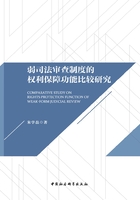
五 可能的创新与不足
(一)本书的创新点
和既有研究相比,本书或许在以下三个方面有所创新。
第一,研究视角的转变。目前,关于弱司法审查制度的研究之所以陷入各方学者自说自话的境地,很大程度上是因为没有把该制度放到其生长和发展的历史脉络中观察。有鉴于此,本书不再像既有研究那样“求新”,而是观察弱司法审查制度本身建立、发展和实践的逻辑。这也意味着,本书是站在旁观者的立场,以一种相对中立的态度定义和评价弱司法审查制度。或许这有助于我们更接近——尽管未必就是——弱司法审查制度的真实面向。
第二,本书论证了弱司法审查制度没有从根本上否定议会至上体制,而是对它进行完善和发展。制定权利法案、要求议会立法与权利保持一致、赋予法官司法审查权等弱司法审查制度的要素看起来似乎是对议会至上体制的挑战,但本书尝试论证弱司法审查制度虽然是政治力量妥协的产物,却在事实上开启了一条制度创新之路。这些制度层面的变革均可以在关于议会至上体制的理论中获得解释。更重要的是,从价值取向上看,它们与议会至上体制推崇的自由价值观之间是一脉相承的。
第三,本书揭示了现实中的弱司法审查制度存在以法院为中心的格局。虽然制度设计者希望通过分散权利保障责任,让政府、议会和法院充分发挥各自的优势,通过权力主体间的对话实现最佳的权利保障效果,但实证研究表明,现实中的弱司法审查制度却呈现出以法院为中心的格局:在立法前权利审查阶段,由于内阁通过政党政治控制了议会,导致后者几乎无法有效地审议政府法案,政府则通过揣测法院意见来决定是否推进系争立法;在司法审查阶段,法官奉行有限能动的司法哲学,极大提高了法院对于权利的保障作用;在立法回应阶段,议会通常会选择遵从司法判决并据此对系争立法作出调整。尽管如此,以法院为中心和司法至上之间仍然存在本质区别。
(二)本书研究的不足
本书将弱司法审查制度作为主要研究对象,重点讨论了它与传统议会至上体制的关系及其具体实践效果,但在横向维度的比较研究上有所不足。第一,在相关章节,本书只在一般层面讨论了弱司法审查制度相比议会至上和司法至上两种模式具有的优势,但没有进行集中深入的分析。或许只有围绕某一带有普遍性的权利保障问题,比较三种制度模式解决该问题的路径,才能更好地说明弱司法审查制度的优势。第二,功能主义的研究进路决定了本书会重点关注那些明面上的制度设计,但对于诸如政治背景、历史文化等隐性因素的影响则关注不够。弱司法审查制度能否以及在多大程度上可以成为其他国家的参照对象,这些因素同样发挥着至关重要的作用。以上两点缺憾有待后续研究加以弥补和完善。
[1] Section 2 of Canadian Bill of Rights,条文具体内容详见加拿大司法部官方网站:https://laws-lois.justice.gc.ca/eng/acts/C-12.3/page-1.html,2019年6月23日访问。
[2] Section 24 and Section 52 of the Canadian Charter of Rights and Freedoms 1982,条文具体内容详见加拿大政府官方网站:https://www.canada.ca/en/canadian-heritage/services/how-rights-protected/guide-canadian-charter-rights-freedoms.html,2019年6月23日访问。
[3] [英]韦农·波格丹诺:《新英国宪法》,李松锋译,法律出版社2014年版,第67—114页。
[4] Mark Tushnet,“Forms of Judicial Review as Expressions of Constitutional Patriotism”,Law and Philosophy,Vol.22,No.3,2003,pp.353-379.为表述方便,本书沿用“弱司法审查制度”作为对新模式的称谓,但在对新模式的理解上与图施耐特存在差别,具体理由参见导论第四部分。
[5] Ran Hirschl,Towards Juristocracy:The Origins and Consequences of the New Constitutionalism,Cambridge:Harvard University Press,2004,pp.221-223.
[6] [英]理查德·贝拉米:《政治立宪主义》,田飞龙译,法律出版社2014年版,第60—62页。
[7] Stephen Gardbaum,The New Commonwealth Model of Constitutionalism,New York:Cambridge University Press,2013,p.61.
[8] Paul C.Weiler,“Rights and Judges in a Democracy:A New Canadian Version”,University of Michigan Journal of Law Reform,Vol.18,1984,pp.51-92.
[9] P.W.Hogg,A.A.Bushell,“The Charter Dialogue Between Courts and Legislatures”,Osgoode Hall Law Journal,Vol.35,No.1,1997.
[10] Kent Roach,“Dialogic Judicial Review and Its Critics”,Supreme Court Law Review,Vol.23,2004,p.66.
[11] Christopher P.Manfredi,James B.Kelly,“Six Degrees of Dialogue:A Response to Hogg and Bushell”,Osgoode Hall Law Journal,Vol.37,No.3,1999.
[12] Kent Roach,“Dialogic Judicial Review and Its Critics”,Supreme Court Law Review,Vol.23,2004,pp.49-104.
[13] Peter W.Hogg,Allison A.Bushell,“Charter Dialogue Revisited or ‘Much Ado about Metaphors’”,Osgoode Hall Law Journal,Vol.45,No.1,2007,pp.1-65.
[14] Tom Hickman,“Constitutional Dialogue,Constitutional Theories and the Human Rights Act 1998”,International Organization,Vol.51,No.4,2005,pp.555-589.
[15] Danny Nicol,“Law and Politics after the Human Rights Act”,Public Law,2006,pp.722-751.
[16] Tom Hickman,“Constitutional Dialogue,Constitutional Theories and the Human Rights Act 1998”,International Organization,Vol.51,No.4,2005,pp.555-589.
[17] Alison Young,Democratic Dialogue and the Constitution,Oxford:Oxford University Press,2017.
[18] Andre Butler,Petra Butler,The New Zealand Bill of Rights Act:A Commentary,Wellington:LexisNexis NZ Limited,2005.
[19] Tom Hickey,“The Republican Virtues of the ‘New Commonwealth Model of Constitutionalism’”,I·CON,Vol.14,No.4,2016,pp.794-816.
[20] Stephen Gardbaum,The New Commonwealth Model of Constitutionalism,New York:Cambridge University Press,2013.
[21] Mark Tushnet,Weak Courts,Strong Rights,Judicial Review and Social Welfare Rights in Comparative Constitutional Law,Princeton:Princeton University Press,2008.
[22] Mark Tushnet,“Judicial Activism or Restraint in a Section 33 World”,University of Toronto Law Journal,Vol.53,No.1,2003,pp.89-100.
[23] Ming-Sung Kuo,“Discovering Sovereignty in Dialogue:Is Judicial Dialogue the Answer to Constitutional Conflict in the Pluralist Legal Landscape?”,Canadian Journal of Law and Jurisprudence,Vol.26,No.2,2013,pp.341-376.
[24] Ming-Sung Kuo,“In the Shadow of Judicial Supremacy:Putting the Idea of Judicial Dialogue in Its Place”,Ratio Juris,Vol.29,No.1,2016,pp.83-104.
[25] James B.Kelly,Matthew A.Hennigar,“The Canadian Charter of Rights and the Minister of Justice:Weak-Form Review Within a Constitutional Charter of Rights”,I·CON,Vol.10,No.1,2012,pp.35-68.
[26] Jeffrey Goldsworthy,“Judicial Review,Legislative Override and Democracy”,Wake Forest Law Review,Vol.38,2003,pp.451-472.
[27] Stephen Gardbaum,“Reassessing the New Commonwealth Model of Constitutionalism”,American Journal of Comparative Law,Vol.49,No.4,pp.707-760.
[28] Janet L.Hierbert,Charter Conflicts:What is Parliament's Role?,Montreal:McGill-Queen's University Press,2002.
[29] Janet L.Hiebert,“Rights-Vetting in New Zealand and Canada:Similar Idea,Different Outcomes”,New Zealand Journal of Public and International Law,Vol.3,No.1,2005,pp.63-103.
[30] Janet L.Hiebert,James B.Kelly,Parliamentary Bills of Rights:The Experience of New Zealand and the United Kingdom,Cambridge:Cambridge University Press,2015.
[31] Mark Tushnet,“Weak-Form Judicial Review and ‘Core’ Civil Liberties”,Harvard Civil Rights-Civil Liberties Law Review,Vol.41,No.1,2006,pp.1-22.
[32] Rosalind Dixon,“Creating Dialogue about Socioeconomic Rights:Strong-Form versus Weak-Form Judicial Review Revisited”,I·CON,Vol.5,No.3,2007,pp.391-418.
[33] 程雪阳:《司法审查的第三条道路——弱司法审查的兴起、发展及其中国意义》,《甘肃行政学院学报》2011年第5期。
[34] 程雪阳:《香港基本法第158条与司法审查次终性理念——基于基本法实施20周年的反思》,《武汉大学学报》(哲学社会科学版)2017年第6期。
[35] 李蕊佚:《议会主权下的英国弱型违宪审查》,《法学家》2013年第2期。
[36] 李蕊佚:《司法审查制度的优化:民主对话理论》,《法学评论》2013年第1期。
[37] 张鹏:《加拿大司法审查对话体制的比较优势与运行困境》,《国外社会科学》2018年第1期。
[38] 王锴:《强形式司法审查抑或弱形式司法审查?——一场有关司法审查性质的论战》,《清华法治论衡》2013年第2期。
[39] Aileen Kavanagh,“What's So Weak About ‘Weak-Form Review’?The Case of the UK Human Rights Act 1998”,I·CON,Vol.13,No.4,2015,pp.1008-1039;Aileen Kavanagh,“The Lure and The Limits of Dialogue”,University of Toronto Law Journal,Vol.66,No.1,2016,pp.83-120.
[40] [英]马丁·洛克林:《公法与政治理论》,郑戈译,商务印书馆2013年版,第185—191、342—345页。
[41] 为行文方便,如无特别说明,本书以“权利法案”作为对加拿大1982年宪章、新西兰1990年权利法案法和英国1998年人权法的统称。
[42] Stephen Gardbaum,The New Commonwealth Model of Constitutionalism,New York:Cambridge University Press,2013,p.30.
[43] 关于违宪审查及其预设的审查方法,更加详细的讨论可参见王书成《合宪性推定论:一种宪法方法》,清华大学出版社2011年版,第173—177页。
[44] Stephen Gardbaum,The New Commonwealth Model of Constitutionalism,New York:Cambridge University Press,2013,pp.204-210.
[45] Stephen Gardbaum,The New Commonwealth Model of Constitutionalism,New York:Cambridge University Press,2013,pp.217-221.
[46] Brian Galligan,Emma Larking,“Rights Protection:The Bill of Rights Debate and Rights Protection in Australia's States & Territories”,Adelaide Law Review,Vol.28,2007,pp.185-186.